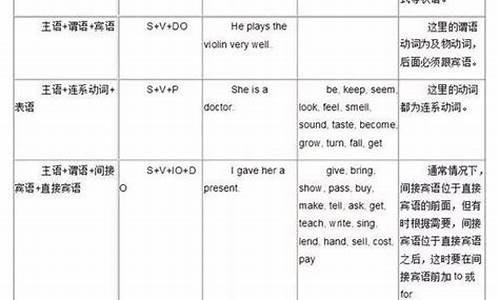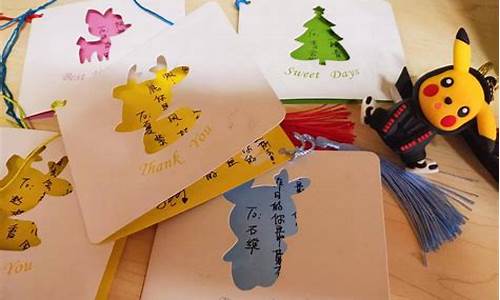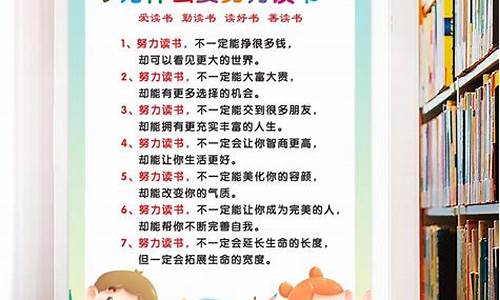您现在的位置是: 首页 > 正能量的句子 正能量的句子
英语七大基本句子结构_英语七种基本句子结构的例句
tamoadmin 2024-08-15 人已围观
简介1.基础英语之基本句子结构2.英语各种类型句子的结构(小学-初中)3.求英语句子结构求一例句概括全部!4.英语除了简单句,还有什么句式,每种写2个例句。5.英语句型结构及例句 #英语# 导语随着全球化与多元文化的发展,英语正跻身为一种国际语言被广泛使用。以下是由 精心收集了英语句子结构,供大家欣赏学习! 篇一英语句子结构分析研究 一、主语(subject): 句子说明的人或事物。 Th
1.基础英语之基本句子结构
2.英语各种类型句子的结构(小学-初中)
3.求英语句子结构求一例句概括全部!
4.英语除了简单句,还有什么句式,每种写2个例句。
5.英语句型结构及例句

#英语# 导语随着全球化与多元文化的发展,英语正跻身为一种国际语言被广泛使用。以下是由 精心收集了英语句子结构,供大家欣赏学习!
篇一英语句子结构分析研究
一、主语(subject): 句子说明的人或事物。
The sun rises in the east. (名词)
He likes dancing. (代词)
Twenty years is a short time in history. (数词)
Seeing is believing. (动名词)
To see is to believe. (不定式)
What he needs is a book. (主语从句)
It is very clear that the elephant is round and tall like a tree.
(It形式主语,主语从句是真正主语)
二、谓语(predicate):说明主语的动作、状态和特征。
We study English.
He is asleep.
三、表语(predicative):系动词之后的成分,表示主语的性质、状态和特征。
He is a teacher. (名词)
Seventy-four! You don’t look it. (代词)
Five and five is ten. (数词)
He is asleep. (形容词)
His father is in. (副词)
The picture is on the wall. (介词短语)
My watch is gone / missing / lost. (形容词化的分词)
To wear a flower is to say “I’m poor, I can’t buy a ring. ” (不定式)
The question is whether they will come. (表语从句)
常见的系动词有: be, sound(听起来), look(看起来), feel(摸起来),smell(闻起来),
taste(尝、吃起来), remain(保持,仍是), feel(感觉) ….
It sounds a good idea.
The sound sounds strange.
Her voice sounds sweet.
Tom looks thin.
The food smells delicious.
The food tastes good.
The door remains open.
Now I feel tired.
三、宾语:
1)动作的承受者——动宾
I like China. (名词)
He hates you. (代词)
How many do you need? We need two. (数词)
We should help the old and the poor.
I enjoy working with you. (动名词)
I hope to see you again. (不定式)
Did you write down what he said? (宾语从句)
2)介词后的名词、代词和动名词——介宾
Are you afraid of the snake?
Under the snow, there are many rocks.
3) 双宾语——间宾(指人)和直宾(指物)
He ge me a book yesterday.
Give the poor man some money.
篇二英语句子结构分析研究
一、宾补:对宾语的补充,全称为宾语补足语。
We elected him monitor. (名词)
We all think it a pity that she didn’t come here. (名)
We will make them hy. (形容词)
We found nobody in. (副词)
Please make yourself at home. (介词短语)
Don’t let him do that. (省to不定式)
His father advised him to teach the lazy boy a lesson. (带to不定式)
Don’t keep the lights burning. (现在分词)
I’ll he my bike repaired. (过去分词)
二、主补:对主语的补充。
He was elected monitor.
She was found singing in the next room.
He was advised to teach the lazy boy a lesson.
三、定语:修饰或限制名词或代词的词、词组或句子。
Ai Yanling is a chemistry teacher.(名词)
He is our friend. (代词)
We belong to the third world. (数词)
He was advised to teach the lazy boy a lesson.(形容词)
The man over there is my old friend.(副词)
The woman with a baby in her arms is my sister. (介词)
The boys playing football are in Cla2. (现在分词)
The trees planted last year are growing well now. (过去分词)
I he an idea to do it well. (不定式)
You should do everything that I do. (定语从句)
四、状语:用来修饰v., adj., adv., or 句子。 表示时间、地点、原因、目的、结果、程度、条件、方式和让步。
(以下例句按上述顺序排列) I will go there tomorrow.
The meeting will be held in the meetingroom.
The meat went bad because of the hot weather.
He studies hard to learn English well.
He didn’t study hard so that he failed in the exam.
I like some of you very much.
If you study hard, you will pathe exam.
He goes to school by bike.
Though he is young, he can do it well.
篇三英语句子结构分析研究
1、简单句
简单句,即只有一个主谓结构的句子。除了特殊情况,英语句子中都有主语、谓语(或表语),有时候还有宾语;而且除了倒装句等特殊句型,一般情况下,主语、谓语、宾语的先后顺序是固定的,不可能宾语跑到谓语前面,或者谓语跑到主语前面。目前很多语法书都把英语的简单句归纳为五种基本句型。实际上,英语简单句还可以简化为三种形式:
主语 + 谓语(及物动词) + 宾语;I hate grammar.
主语 + 谓语(不及物动词); Grammar sucks.
主语 + 系动词 + 表语 Grammar is hell.
所以,我们在阅读句子的时候,不管句子有多长,不管是并列句还是复合句,都必须首先分清各句中的主语、谓语(或表语),有的句子中还包括宾语。因为主语、谓语、宾语中英语句子的主干,抓住了句子的主干,句子的基本意思就清楚了。
2、并列句
并列句就是两个或以上的简单句,由表示并列关系的连词或标点符号连接而成。常见的连词:and, not only...but also, neither...nor... or, either...or... otherwise,but, yet, while, so, for等。阅读中遇到并列关系的句子,一般情况下是以连词为界限,将句子分成前、后几个部分,并分别来分析,各句的意思一般可以单独理解,最后将各句合并即可。
I hate grammar, / while he loves it. (以while为界,可分为前后两个小句子)
3、 主从复合句
主从复合句即是复杂句,它也是由两个以上的句子构成。与并列不同的是,各分句之间的意思是紧密相连的,所以我们不能简单地把各个句子拆开来看,而必须将各分句综合起来进行理解。有时候,分句里面有可能还包含分句。
说到从句,我们还要介绍一下英语中的三大从句:名词性从句,形容词性从句和副词性从句。三大从句之下又包括纷繁复杂的从句形式:
名词性从句:主语从句,宾语从句,表语从句, 同位语从句
形容词性从句(定语从句):限制性,非限制性
副词性从句(状语从句):时间,地点,原因,条件,目的,让步,方式,结果
看到这里,可能有些同学又会产生抵触情绪了,其实这些细致的划分我们可以跳过,对于具体句子中的从句如何解决其实很简单,你只需知道从句做什么成分就可以了,从句做什么成分,就是个什么功能的从句。
The sad thing is that the ugly man with a lot of money chooses living alone. (表语)
What the ugly man chooses is living alone.(主语)
We all know that the ugly man chooses living alone.(宾语)
The thing that the ugly man with a lot of money chooses living alone was known to everyone. (同位语)
The ugly man who has a lot of money chooses living alone.(定语)
Although the ugly man has a lot of money, he chooses living alone.(状语)
在阅读这样的复杂句的时候,首先要找出主句或从句从哪儿开始,到哪儿结束,首先理解主句的意思,最后再把从句的内容与主句综合起来。
介绍完句子结构,就该说说复杂句子的解决方法了,那就是优先提取主干法。这种方法顾名思义就是先把句子的主干提取,因为主干是句子的精髓所在,然后再看其他补充或修饰的成分。
One of the results of the conflict between the two factions was that [ what in previous years had been referred to as the "American", "native", or, occasionally, "New York" school (---the most representative school of American art in any genre--- ) 主语从句] ( had by 1890) was firmly established in the minds of critics and public alike as the Hudson River school. 表语从句
首先找到句子主干成分:"One of the results was..."很明显的主系表结构,that 引导的显然是个表语从句,表语从句中又有一个由What引导的主语从句,主干结构是"...was firmly established." 最后再加上修饰成分,句子就很容易分析了,也可以轻而易举的翻译并理解了:两个派别斗争的结果之一是:直到1890年,这个曾经被称作"美国的"、"本土的"、或者偶尔被称作是"纽约的"美国艺术题材中最有代表性的学派,以哈德逊河学派命名被稳固的建立在批评家和公众的思想之中了。
优先提取主干是一个很有效地方法,如果我们具备了基本的句子结构知识,了解了句子的成分构成,先提取主干,抓住句子精髓,再看从句和其他部分,理清各个部分之间的关系,任何复杂的句子也就迎刃而解了。
基础英语之基本句子结构
1、Subject (主语) + Verb (谓语动词)
2、Subject (主语) + Link. V(系动词) + Predicate(表语)复合谓语
3、Subject(主语) + Verb (谓语动词) + Object (宾语)
等。仅供参考。 扩展资料
一、Subject (主语) + Verb (谓语动词)
这种句型中的动词大多是不及物动词,常见的动词如:work, sing, swim, fish, jump, arrive, come, die, disear, cry, hen等。如:1) Li Ming works very hard.李明学习很努力。2) The little girl cried even harder.小女孩哭得更厉害了。3) The accident hened yesterday afternoon.事故是昨天下午发生的。
二、Subject (主语)+Link. V(系动词)+Predicate(表语)
复合谓语这种句型主要用来表示主语的特点、身份等。其系动词一般可分为下列两类:(1)表示状态。这样的词有:be, remain, look, seem, smell, taste, sound, keep, feel等。如:1) This kind of food tastes delicious.这种食物吃起来很可口。2) He looked worried just now.刚才他看上去有些焦急。(2)表示变化。这类系动词有:become, turn, get, grow, go等。如:1) Spring comes. It is getting warmer and warmer.春天到了,天气变得越来越暖和。2) The tree has grown much taller than before.这棵树比以前长得高多了。
三、Subject(主语)+Verb (谓语动词)+Object (宾语)
这种句型中的动词一般为及物动词。其宾语通常由名词、代词、动词不定式、动名词或从句等来充当。例:1) He took his bag and left.(名词)他拿着书包离开了。2) Li Lei always helps me when I he difficulties. (代词) 当我遇到困难时,李雷总能给我帮助。3) She plans to trel in the coming May Day.(不定式)她打算在即将到来的“五一”外出旅游。4) I don’t know what I should do next. (从句)我不知道下一步该干什么。
※只能跟不定式作宾语的动词:want, hope, expect, intend, demand, plan, decide, determine, promise, agree, refuse, prepare, manage, set out等。
※只能跟动名词作宾语的动词:suggest, mind, enjoy, practice, finish, prevent, imagine, consider, look forward to, get used to, give up, can’t help等。
四、Subject(主语)+Verb(谓语动词)+Indirect object(间接宾语)+Direct object (直接宾语)
这种句型中,直接宾语为主要宾语,在句中不可或缺,常常由表示“物”的名词来充当;间接宾语也被称之为第二宾语,去掉之后,对整个句子的影响不大,多由指“人”的名词或代词承担。引导这类双宾语的常见动词有:buy, pass, lend, give, tell, teach, show, bring, send等。如:1) Her father bought her a dictionary as a birthday present. 她爸爸给她买了一本词典作为生日礼物。2)The old man always tells the children stories about the heroes in theLong March.老人经常给孩子们讲述长征途中那些英雄的故事。上述句子还可以表达为:1)Her father bought a dictionary for her as a birthday present.2)The old man always tells stories about the heroes to the children in the Long March.
五、Subject(主语)+Verb (谓语动词)+Object (宾语)+Complement(补语)
这种句型中的“宾语+补语”统称为“复合宾语”。宾语补足语的主要作用或者是补充、说明宾语的特点、身份等;或者表示让宾语去完成的动作等。担任补语的'常常是名词、形容词、副词、介词短语、分词、动词不定式等。如:1)You should keep the room clean and tidy.你应该让屋子保持干净整洁。(形容词)2) We made him our monitor.(名词)我们选他当班长。3) His father told him not to play in the street.(不定式)他父亲告诉他不要在街上玩。●常见的动词有: tell, ask, advise, help, want, would like, order, force, allow等。●注意:动词he, make, let, see, hear, notice, feel, watch等后面所接的动词不定式作宾补时,不带to。如:1) The boss made him do the work all day.老板让他整天做那项工作。2) I heard her sing in the next room all the time last night.昨天晚上我听见她在隔壁唱了一个晚上。
六、There be +主语+其它
这一结构表示“某地有某物”。主语一般位于there be之后。值得关注的是,当句中有两个或更多的主语时,动词一般和最近的一个保持一致:1)There are two girls and a boy running on the playground.有两个女孩和一个男孩正在操场上跑。
2)There is a cat behind the tree.树后面有一只猫。
英语各种类型句子的结构(小学-初中)
基础英语之基本句子结构
导语:想更扎实英语的基础?下面是我整理的基础英语之基本句子,希望对你有帮助!
感叹句
感叹句是表达喜、怒、哀、乐以及惊奇、惊讶等强烈感情的句子。感叹句通常由 what 或 how 引导。现分述如下:
一、由 what 引导的感叹句,其句子结构可分为以下三种:
1. 可用句型:? What + a/an +形容词+可数名词单数+主语+谓语!?。如:
What a nice present it is! 它是一件多么好的礼物啊!
What an interesting book it is! 它是一本多么有趣的书啊!
2. 可用句型:? What +形容词+可数名词复数+主语+谓语!?。如:
What beautiful flowers they are! 多么漂亮的花啊!
What good children they are! 他们是多么好的孩子啊!
3. 可用句型:? What +形容词+不可数名词+主语+谓语!?。如:
What fine weather it is today! 今天天气多好啊!
What important news it is! 多重要的新闻啊!
二、由 how 引导的感叹句,其句子结构也分为三种:
1. 可用句型:? How +形容词 / 副词+主语+谓语!?。如:
How careful she is! 她多么细心啊!
How fast he runs! 他跑得多快啊!
2. 可用句型:? How +形容词+ a/an +可数名词单数+主语+谓语!?。如:
How beautiful a girl she is! 她是个多么漂亮的姑娘啊!
3. 可用句型:? How +主语+谓语!?。如:
How time flies! 光阴似箭!
由 what 引导的感叹句与由 how 引导的感叹句有时可以转换,但句中部分单词的'顺序要有所变化。如:
How beautiful a girl she is! = What a beautiful girl she is!
What delicious cakes these are! = How delicious these cakes are!
三、有时感叹句也可以由一个单词、词组、祈使句、陈述句等构成。
如: Good idea! (好主意!) wonderful! (太精彩了!) Thank goodness! (谢天谢地!)
祈使句用于表达命令、请求、劝告、警告、禁止等的句子叫做祈使句,祈使句最常用于表达命令。
祈使句因对象(即主语)是第二人称,所以通常都省略。祈使句的动词都为一般现在时,句末则使用句号来表示结束。例:
Go and wash your hands.(去洗你的手。?命令)
Be quiet, please.(Please be quiet.)(请安静。?请求)
Be kind to our sister.(对姊妹要和善。?劝告)
Watch your steps.(走路小心。?警告)
Look out!Danger!(小心!危险!?强烈警告,已如感叹句)
Keep off the grass.(勿践草坪。?禁止)
祈使句也常把主语?You?表达出来,使对方听起来觉得柔和些,例如:You go and tell him, Chris.(克立斯去告诉他。)
相关口令:
祈使句无主语,主语you常省去;
动词原形谓语当,句首加don't否定变;
朗读应当用降调,句末常标感叹号。
表现形式:
肯定结构:
1. Do型(即:动词原形(+宾语)+其它成分)。如:Please he a seat here. 请这边坐。有的祈使句在意思明确的情况下,动词可省略。如:This way, please. = Go this way, please. 请这边走。
2. Be型(即:Be + 表语(名词或形容词)+其它成分)。如:Be a good boy! 要做一个好孩子!
3. Let型(即:Let + 宾语 + 动词原形 + 其它成分)。如:Let me help you. 让我来帮你。
否定结构:
1. Do型和Be型的否定式都是在句首加don't构成。如:Don't forget me! 不要忘记我!
2. Let型的否定式有两种:?Don't + let + 宾语 + 动词原形 + 其它成分?和?Let + 宾语 + not + 动词原形 + 其它成分?。如:Don't let him go. / Let him not go. 别让他走。
3. 有些可用no开头,用来表示禁止性的祈使句。如:No smoking! 禁止吸烟!
疑问句疑问句的主要交际功能是提出问题,询问情况。分为一般疑问句、选择疑问句、特殊疑问句和反意疑问句。
一般疑问句:
Do you speak English? 你讲英语吗?
选择疑问句:
Do you like to play football or basketball? 你喜欢踢足球还是打篮球?
特殊疑问句:
Which book is yours? 哪一本书是你的?
反意疑问句:
It's cold today, isn't it?
陈述句陈述句主要是用来陈述事实或观点,传递信息,提供情况。
陈述句又分为肯定的陈述句和否定的陈述句,简称为肯定句(The Affirmative Sentence)和否定句(The Negative Sentence)两种。
陈述句在书写时句末有句号,而在朗读时则用降调。
例句:
China is the largest country in Asia.
中国是亚洲最大的国家。
I didn't tell him anything.
我什么也没有告诉他。
;求英语句子结构求一例句概括全部!
义务教育阶段英语要求掌握的句型:
英语的句子有6种基本结构。
1.主语+系动词+表语(A is B.)
[例句]
哈佛是最早接受中国留学生的美国大学之一。
Harvard is among the first American universities to accept Chinese students.
2.主语+及物动词+宾语(A does B.)
[例句]
这些传统,对今天中国人的价值观念、生活方式和中国的发展道路,具有深刻的影响。
These traditions he exerted a profound impact on the values and way of life of the Chinese people, and on China’s road of development today.
3.主语+不及物动词(A lees.)
[例句]
1847年,中国最早的一批留美学生容闳等人赴美求学。
In 1847, Chinese student Rong Hong and others came to the United States as the first group of Chinese students to study here.
4.主语+及物动词+双宾语(间接宾语指人,直接宾语指物)(A gives B something.)
[例句]
昨天,我参观了国际商用机器公司、美国电话电报公司和贝尔实验室,领略了当代科技发展的前沿成就。
My visit to IBM, AT&T and the Bell laboratory yesterday ge me some first-hand knowledge of the latest successes in modern science and technology.
5.主语+及物动词+复合宾语(即宾语+宾语补足语)(A tells B to do something)
[例句]
今天,正在为实现现代化而奋斗的中国人民,把对外开放作为一项基本国策。
Today, the Chinese people who are struggling to achieve modernization he made the opening-up a basic state policy.
6.There+系动词+主语(There is a man.)
[例句]
在自由市场经济国家企业类型有多种多样。
There are many types of businesses in a free-market economy.
如果有什么问题,详情我可以给你讲解。
英语除了简单句,还有什么句式,每种写2个例句。
主语+谓语。 例如:I know .
主语+谓语(系动词)+表语。 例如:I am hungry .
主语+谓语+宾语。 例如:I know her .
主语+谓语+宾语+宾语补足语。 例如:I hear him singing .
主语+谓语+宾语+状语。 例如:I saw him yesterday .
这是几种简单的句型结构,如要一次学全还得好好看看书。
英语句型结构及例句
二.并列句。 结构: 1.由分号连接。 eg. Some people cry; others laugh. Let’s start early; we he a long way to go. 2.由并列连词及词组连接-——and/ but /or/ so / however / still/ therefore /yet /while /otherwise /for /both…and…/not only…but also…/as well as/ or else/ either…or…/neither…nor…/not…but…等。 eg: I’d like to, but I he lots of homework to do. I’ve got a cold, so I’m going to bed. 1. 否定句型
1) 一般否定句
I don’t know this. No news is good news.
There is no person (smoke)/not a person/not any person (smoke) in the house.
2)特指否定
He went to his office, not to see him.
I am sorry for not coming on time.
I don’t think/believe/suppose/feel/imagine you are right.
3)部分否定
All the answers are not right
All is not gold that glitters
I don’t know all of them.
I can’t see everybody/everything.
Both of them are not right.
4)全体否定
None of my friends smoke.
I can see nothing/nobody.
Neither of them is right.
Nothing can be so simple as this.
5) 延续否定
You didn’t see him, neither/nor did I.
You don’t know, I don’t know either.
He doesn’t know English, let alone/to say nothing of/not to speak of (更不用说) French.
6) 半否定句
We seldom/hardly/scarcely/barely hear such fine singing.
I know little English. I saw few people.
7) 双重否定
You can’t make something out of nothing.
What’s done cannot be undone.
There is no sweet without sweat.
No gain without pains.
I can’t help /keep/ laughing whenever I hear it.
No man is so old but (that) he can learn.
8)排除否定
Everyone is ready except you.
He did nothing but play.
But for your help, I couldn’t do it.
9)加强否定
I won’t do it at all.
I can’t see it any more.
He is no longer a boy.
2. 判断句型
1) 一般判断句
It is important for us to learn English.
It is kind of you to help me
sincere means honest.
The boy is called/named Tom.
We regarded/consider it as an honor.
2)强调判断
It is English that we should learn.
It is he who helped me a lot.
3)弱式判断
Your sentence doesn’t sound/look/ear/feel right.
You look/seem as if/as thought you had been there before.
Maybe/Perhaps/ she is ill.
He is probably ill.
He is likely ill.
It is possible that he is late
4) 注释判断
He can remember so many English words, that is (to say) he is a living dictionary.(活字典)
5) 正反判断
That sounds all right, but in fact it is not.
6) 比较判断
It is more a picture than a poem.
7) 互斥判断
He or you are wrong.
Either he is right or I am.
3. 祝愿祁使句式
1) 一般句式
Study hard and keep fit.
Be bre! Don’t be shy!
Get out of here.
2)强语式
Do tell me.
Never tell a lie.
3) 委婉祈使句
Please tell me the true.
Would/Will/Won’t do me a for?
Would/Do you mind my smoking?
What/How/ about going on foot?
4)建议祈使句
Let us go. Let us know the time.
Don’t let the fire out.
Let’s not waste the time.
You’d better start early.
Shall we listen to some music?
Why don’t you get something to drink?
Suppose/supposing you pick me up at about six?
I suggest we (should) take the train.
5)祝愿句
Success to you!
Wish you a good journey.
May you he a hy marriage.
Here’s to your success!
Allow me to propose a toast to our friendship!
4. 感叹句型
How well he speaks!
How kind she is!
What a nice weather it is!
Here he comes!
Such is life!
Wonderful!
Help!
英语的句子成分有8种,分别是主语(subject)、谓语(predicate)、宾语(object)、表语(predicative)、定语(attribute)、状语(adverbial)、补语(complement)和同位语(ositive)。
学会判断句子成分对以后学习难句和理解文段奠定了基础。英语句子的构成也有其特定的规律,掌握了句子的基本句型、常见句式和词语的习惯搭配,就能写出完整、正确的句子。
一、句子成分和基本句型讲前练指出下列句子中划线部分的句子成分并总结出该句的基本句型结构。1.They he worked for months and even years.成分:主语谓语时间状语句型结构总结:主语+谓语(不及物动词)
2.The film you see on the screen is the product of a huge amount of hard work成分:主语?定语 谓语?表语句型结构总结:主语+系动词+表语?
3.I didn’t understand all of the traditional customs at first.成分:?主语谓语宾语?状语?句型结构总结:主语+谓语(及物动词)+宾语?
4.Traditional festivals teach us a lot about our nation’s history成分:主语 谓语?间接宾语直接宾语?句型结构总结:主语+谓语(及物动词)+双宾语(间接宾语+直接宾语)?
5.Traditional festivals enable usto learn fine Chinese values成分:?主语谓语宾语宾语补足语句型结构总结:?主语+谓语+复合宾语(宾语+补语) ?小结:从以上的练习中可知英语中的句子成分包括:主语,谓语,宾语,表语,定语,状语,宾语补语
6.He was seenplaying basketball?on the playgroundyesterday.(现在分词短语作主语补足语)
二、句子成分和基本句型精讲
(一)、句子成分
1、主语:?说明句子所谈的是:“什么人”或“什么物”,主语通常由名词、代词或相当于名词的词或短语充当。EG:Lucylikes her new car very much.?露西喜欢她的新车。名词作主语Hegoes to and from schoolby bike every day.他每天都起得很早。(代词作主语)To learn English wellis a challenge.学好英语是一项挑战性工作。不定式短语作主语
2、谓语:?说明主语“做什么”、“是什么”或“怎么样”,英语中谓语只能用动词充当。例如:Weworkhard.我们努力工作。The boy?caught?a bird.?那个男孩逮住一只鸟。Heislike his father.?他像他父亲。注意:介词不能作谓语,必须与be动词连用,构成系表结构,一起作谓语。谓语和主语在人称和数方面必须保持一致。EG:Music isthe utmost pleasure in life.音乐是人生最大的快乐。AsI take?each bite,?the sweet and mild flour of the red bean filling?slowly?fills?my mouth.
3、宾语:?宾语是动作的对象。由名词、代词或相当于名词的词或短语充当,说明主语做?“什么”。EG:Tom boughta story-book.汤姆买了一本故事书。名词作宾语I sawhim?yesterday.?昨天我看到他了。代词宾语He decidedto run away from home.?他决定离家出走。不定式短语作宾语注意:宾语分为直接宾语和间接宾语:有些及物动词可以有两个宾语,一个指人,一个指物,指人的叫作间接宾语,指物的叫直接宾语;合称双宾语。EG:I boughtmy sona box of Mark pens?last night.?他给了我一些墨水。间接宾语?直接宾语Our teacher toldusaninteresting story.?老师给我们讲了一个有趣的故事。间接宾语直接宾语
4、表语:说明主语“是什么”或“怎么样”;与连系动词一起构成谓语,表语由名词、形容词、或相当于名词或形容词的词或短语等充当;用在系动词后面。EG:I he been an English teacher since I graduated from university.我的姐姐是一名护士。名词作表语Terry seems in low spirits today.特瑞今天好像情绪低落。介词短语Tom’s dream has become true already.?汤姆的梦想已经实现。形容词作表语
5、定语:修饰名词或代词的成分,除形容词外,还有名词、代词、数词、介词短语或相当于形容词的词或短语都可以作定语。EG:After years ofhard?work,his career began to take.多年的努力工作之后,他的事业开始腾飞。形容词作定语Are these studentsyour?classmates?这些学生是你班的吗?形容词性物主代词作定语Winter is the coldest seasonof the year.冬天是一年中最冷的季节。介词短语作定语The building to be built next year will be our new teaching building.明年将要修建的建筑物将是我们的新教学楼。不定式作定语The peoplehere?are very friendly.这里的人们非常友好。副词作定语注意:单个形容词作定语时通常放在被修饰的词之前。而介词短语、不定式短语或副词等作定语时则放在被修饰的词之后。
6、状语:?修饰动词、形容词、副词,或修饰全句的成分叫状语。作状语的主要是副词和介词短语或相当于副词的词或短语等。EG:Jack runs veryfast.?杰克跑得很快。副词作状语All these clothes are madeby hand.shua。所有的这些衣服都是手工制作的。介词短语作状语She will arrive in Shanghaion Friday.?她将于星期五到达上海。介词短语作状语To pass the weekly test,he is studying very hard.?为了通过周考,他正在努力学习。不定式短语状语
7、宾语补足语:?有些及物动词的宾语后边还需要有一个成分来说明宾语的情况,意思才能够完整,这个成分叫宾语补足语。宾语和补足语构成复合宾语。EG:They always call?me Lao Yang.宾语宾语补足语?名词做宾补You must keep?the roomclean and tidy.宾语?宾语补足语形容词作宾补Mr. Yang invitedme to visit his new house in Huaihua.宾语宾语补足语不定式作宾补I hadmy old housepaintedlast week.宾语?宾语补足语We found?the girls in our classplaying gameson the playground ten minutes ago.宾语?宾语补足语现在分词作宾补
8、主语补足语一个句子有时不足以表达完整的意义,需要再添加一个成分用来补充说明主语的状态,特征和性质,这个成分就是主语补足语。常用来做补语的成分有形容词,名词,数词,不定式,分词和介词短语。Tired and sleepy, I went to bed.宾语补足语所在句子变成了被动语态后,宾语补足语就成了主语补足语。例句:I saw the kiteup and down.(up and down是副词做宾补)The kite was seenup and down.up and down是副词做主补)
9、同位语?同位语对前面的名词或代词作进一步的解释和补充,说明它指的是谁、或者是什么。同位语大多数时候由名词来充当,形容词、代词、数词和从句也可以作同位语。Youchildren?must learn to say please and thank you.你们这些孩子必须学会说请和谢谢。I heard the newsthat our team had won.我听说我们队赢了。句子成分巧记歌诀主谓宾表定状补七种成分记清楚句子主干主谓宾(表)枝叶成分定状补定语修饰主宾表宾语之后常有补主谓人称数一致状语位置最灵活考点对练1:指出下列句子中划线部分的成分。(将划线部分的句子成分写在横线上)
1.Jack and Tom are doingtheir homework?now.宾语?
2.Bettyplantedmany trees and flowerson her farm?谓语 ?
3.The boy under the tree isa policeman.表语 ?
4.We went on a visit to the Great Walllast week?状语
5.Yangjing was mybest?friend in my childhood.?定语?
6.Healways?walks in the park after supper with his wife.状语?
7.Mary asked meto help her?yesterday.?宾语补足语
8.I boughtmy girlfriend a gold ringon her birthday.?双宾语
9.Mr. Weiremains?a doctor.谓语(系动词)
10.The boys and girlsseemed excited?when they heard the news.系表结构
三、简单句的基本句型简单句:由一个主语(或并列主语)和一个谓语(或并列谓语)所构成的句子。简单句分为5种基本句型:
1.主语+谓语(主语?+不及物动词)例1:My little sister can swim? very well.?我妹妹游泳游得很好。主语谓语(不及物动词)例2:The planehas already arrived.?飞机已经抵达。主语?谓语2.主语+谓语+宾语(主语+及物动词+宾语)例3:The poor passengers?on the real Titanic?saw the tip of the iceberg.主语谓语宾语泰坦尼克号上可怜的乘客们看到了冰山的顶部。例4:The company makes films?.?这家公司制作**。主语.谓语?宾语例5:Stanley?bought a flat? last year. ?Stanley去年买了套公寓。主语谓语宾语3.主语+系动词+表语(主语+连系动词+表语)例6:My mother is a scientist.?我母亲是个科学家。主语?谓语表语例7:She looks young.?她看上去很年轻。主语谓语表语例8:The cake tastes? very?yummy.?这蛋糕尝起来很美味。主语?谓语?表语4.主语+谓语+双宾语(主语+及物动词+间接宾语+直接宾语)例9:My mother bought me a dictionary? yesterday. ?我母亲昨天给我买了本字典。主语?谓语?间接宾语?直接宾语例10:Can you give me the math book 你能给我那本数学书吗?谓语?主语?谓语?间接宾语?直接宾语例11:Will you tell us something about your school life?谓语主语谓语间接宾语?直接宾语你给我讲讲你们的学习生活,好吗?5.主语+谓语+复合宾语(主语+及物动词+宾语+补语)例12:We must keep our classroom clean and tidy.?我们必须保持教室干净、整洁。主语谓语宾语宾语补足语例13:My mother asks me to speak English as much as possible.主语?谓语?宾语?宾语补足语我母亲要求我尽可能多地讲英语。例14:I heard her singing hily?in the room just now.主语谓语?宾语?宾语补足语刚才我听到她在房间里高兴地唱着歌。考点对练2:指出下列句子的基本类型1.主语+谓语2.主语+谓语+宾语3.主语+系动词+表语4.主语+谓语+双宾语(间宾?+直宾?)5.主语+谓语+复合宾语(宾?+?宾补)
1.Plants need water and sun.?主+?谓+宾
2.The flowersare so fresh and beautiful.?主?+?系?+?表
3.The sun rises in the east.?主?+?谓4.He ge me some flowers.?主?+?谓?+间宾?+直宾?5.We should keep the classroom clean and tidy.?主?+?谓?+?宾?+?宾补6.Many animals live in trees.主?+?谓7.Her mother looks very young.?主?+?系?+?表8.She teaches us English.主?+?谓?+间宾?+直宾?9.The children are jumping and laughing hily.?主?+?谓10.Our teacher asked us to talk about thequestions in pairs.主?+?谓?+?宾?+?宾补?11. He often tells me some interesting stories.?主?+?谓?+间宾?+直宾12.The students must keep their eyes closed.?主? +?谓?+?宾?+?宾补?四、考点应考技巧1、在语法填空题中,要注意分析句子成分,方能判断空格中应该填什么词性。2、在阅读英语文章遇到长句难句时,要不断培养分析句子成分,抓住句子的主干部分(主谓宾),方能理解好句子含义。
五、句子成分和基本句型考点精练(一)、划出下列高考真题中的句子的主()谓()宾/表语()(有从句时,只划出主句的主谓宾/表)。
The hostelsin Rome?offer a bed?in a dorm room for around $25 a night.来自2021年新高考I卷
2.Unfortunately,it took the explorers and the settlers?who followed?only a few decades形式主语?谓语间接宾语直接宾语to decimate a large part of these resources.来自2021年新高考I卷真正的主语
3.Under this Act,all waterfowl(水禽)hunters?16 years of age and over?must?annually?purchase and carrya Federal Duck Stamp.来自2021年新高考I卷翻译:根据该法案,所有16岁及以上的水禽猎人必须每年购买并携带联邦鸭邮票。4.Research has shown that emotional skills may contribute to some of these qualities.来自2021年新高考I卷?从句作宾语(宾语从句)翻译:研究表明,情感技能可能有助于提高这些品质
5.The abilityto accurately understand how others are feeling?may be used?by a doctor to find how best to help her patients.?来自2021年新高考I卷翻译:准确理解他人的感受的能力可能会被医生用来找到如何最好地帮助她的病人。解析:要理解好这句话还要理解好句式“be used to do sth ”的含义,句式表示“被用来做某事”。6.Take a viewis a desirable annual competition?for photographers from all comers of the UK and beyond.?来自2021年全国甲卷?此句是主系表结构翻译:《取一个观点》对于所有来者的英国和其他地区的摄影师是一个让人渴慕的年度竞争。解析:此句是省略句:beyond?后面省略了?all corners of the UK.
7.Officialsat Port Lympne?were delighted?with the new arrival, especially as black rhinos are主语谓语(系动词)表语介词宾语known for being difficult to breed in captivity (圈养).?来自2021年全国甲卷翻译:林普恩港的官员们对新到来的到来感到高兴,尤其是因为黑犀牛以圈养繁殖(圈养)而闻名。解析:这里as?引导原因状语从句。8.Without my beloved beaches and endless blue-sky days,I felt at a loss and out of place.来自2021年全国甲卷?主语谓语?介词短语作表语翻译:没有我心爱的海滩和无尽的蓝天,我感到不知所措和不自在。解析:without.......一部分是介词短语作状
9.Southbank,at an eastern bend in the Thames,?is the center of British skateboarding,?where the continuous crashing of skateboards left your head ringing.来自2021年全国甲卷翻译:南岸位于泰晤士河东部的一个拐弯处,是英国滑板运动的中心,滑板运动的不断碰撞让你会摇头。解析:此句主干是主系表结构。Where引导的是非限制性定语从句补充说明the center.?而at an eastern bend in the Thames部分是作主语补足语,补充说明Southbank的地理位置
10.I he treledback several times since, most recently this past spring.来自2021年全国甲卷翻译:从那以后我去过几次,最近是去年春天。解析:此句是主谓结构,没有宾语,因为trel是不及物动词。
请点击输入描述
请点击输入描述









